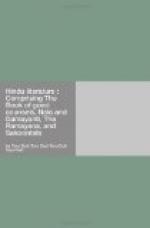In 1876, as we have said, appeared that obscure first volume at Bhowanipore. The “Sheaf gleaned in French Fields” is certainly the most imperfect of Toru’s writings, but it is not the least interesting. It is a wonderful mixture of strength and weakness, of genius overriding great obstacles, and of talent succumbing to ignorance and inexperience. That it should have been performed at all is so extraordinary that we forget to be surprised at its inequality. The English verse is sometimes exquisite; at other times the rules of our prosody are absolutely ignored, and it is obvious that the Hindoo poetess was chanting to herself a music that is discord in an English ear. The notes are no less curious, and to a stranger no less bewildering. Nothing could be more naive than the writer’s ignorance at some points, or more startling than her learning at others. On the whole, the attainment of the book was simply astounding. It consisted of a selection of translations from nearly one hundred French poets, chosen by the poetess herself on a principle of her own which gradually dawned upon the careful reader. She eschewed the Classicist writers as though they had never existed. For her Andre Chenier was the next name in chronological order after Du Bartas. Occasionally she showed a profundity of research that would have done no discredit to Mr. Saintsbury or “le doux Assellineau.” She was ready to pronounce an opinion on Napol le Pyrenean or detect a plagiarism in Baudelaire. But she thought that Alexander Smith was still alive, and she was curiously vague about the career of Sainte-Beuve. This inequality of equipment was a thing inevitable to her isolation, and hardly worthy recording, except to show how laborious her mind was, and how quick to make the best of small resources.
We have already seen that the “Sheaf gleaned in French Fields” attracted the very minimum of attention in England. In France it was talked about a little more. M. Garcin de Tassy, the famous Orientalist, who scarcely survived Toru by twelve months, spoke of it to Mlle. Clarisse Bader, author of a somewhat remarkable book on the position of women in ancient Indian society. Almost simultaneously this volume fell into the hands of Toru, and she was moved to translate it into English, for the use of Hindoos less instructed than herself. In January, 1877, she accordingly wrote to Mlle. Bader requesting her authorization, and received a prompt and kind reply. On the 18th of March Toru wrote again to this, her solitary correspondent in the world of European literature, and her letter, which has been preserved, shows that she had already descended into the valley of the shadow of death:—




